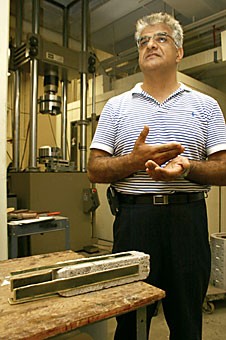The day after the Interstate 35W bridge collapsed in Minneapolis, UA assistant professor Yi-Chang Chiu’s phone rang.
He has since been working around the clock calibrating a computer model to act and think like the millions of Minnesota drivers whose daily routine was altered Aug. 1 by the collapse of one of the city’s major lifelines.
Chiu was asked by the Federal Highway Administration and the Minnesota Department of Transportation to use a traffic simulation model to test and recommend proposed rerouting scenarios aimed to ease congestion in the Minneapolis and St. Paul areas.
The software developed at the UA, mimics real drivers on their commute through the Twin Cities.
It is calibrated to act like the real city based on data sent from the Minnesota Department of Transportation, such as regional demographics, estimated number of cars, census data and commuter surveys, Chiu said.
“”This is a situation no one has ever encountered before,”” he said about the bridge collapse. “”So our job is to take the model we developed to mimic basically the entire city’s traffic movement during rush hour.””
The program Chiu’s team
Professor’s technology could save U.S. bridges
UA civil engineering professor Hamid Saadatmanesh is the founder of Carbon Wrap Solutions, a company that uses paper-thin carbon fiber fabric and specially formulated epoxy to reinforce concrete in earthquake-prone California, an Oklahoma City bridge and underground pipes at a New Mexico power plant.
Carbon Wrap Solutions also used the composite material to fix Minnesota’s I-35W bridge without the hassle and expense of excavation.
The work was completed in only two weeks.
Outside his lab, Saadatmanesh pointed to a 6-inch crack in a steel beam and said, “”Something like that most likely happened at that bridge, because when it gets to this point, the next truck went over it, bang.””
Once a crack forms, he added, the steel tears just like paper.
Carbon fiber laminate on the underside of a beam increases the load-bearing capacity four-fold, Saadatmanesh said.
By wrapping the composite around a concrete column, the column’s strength is increased 10-fold.
“”You can just use it just like a wallpaper on a wall, and then you can blow up a truck-bomb next to it and nothing would happen.””
-Jackson Payne
developed looks like a map of the city with moving green dots representing each driver, simulating their routes.
The operator can then change road conditions, closing off roads, increasing the speed limit or creating construction signs and testing how the drivers will likely respond, Chiu said.
“”Our goal is to predict how traffic may look for every scenario,”” Chiu said.
Millions of drivers, like Minnesota resident David Moore, have been affected by the collapse. He said he drove on the I-35W bridge everyday for years.
Since the collapse, he said he has noticed an increase in traffic congestion all over the city, even overflowing into the surrounding suburbs, as people try to get to work.
“”It’s chaotic,”” Chiu said. “”The traveling public has to take different routes, but the other routes are already congested.””
Civil engineering graduate student Eric Nava has been working alongside Chiu and helped to convert the slew of data received from Minnesota into the traffic simulation model database.
“”It feels really good to know that we’re able to help people out and apply what we do and what we’ve been studying,”” Nava said.
This collaboration could bring national recognition to the UA civil engineering program.
Chiu said that other schools may have models that can simulate one stretch of highway, but the UA is one of few universities that can do a model of an entire city in such a short period of time.
Chiu and his team are working on the short-term goal of easing congestion around the city, but they are also looking at the best long-term solution during the projected 2-year bridge reconstruction.
“”Its an interactive, ongoing process,”” Chiu said.









